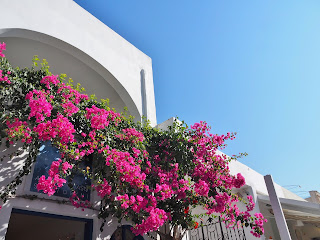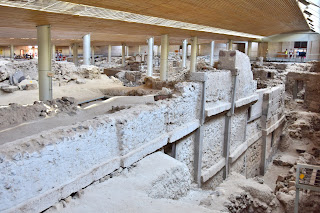We had an early (8:15) departure from the ship, via tenders, to the
port of Athinios at the base of the steep cliffs of Santorini.
Santorini used to be a round island until there was a massive volcanic eruption in 1646 BC. It is now crescent shaped with steep cliffs and a few smaller islands in the caldera of the volcano. Apparently there is still one place just north of the island where fumes still bubble out of the earth’s crust into the waters although we couldn’t see if from our vantage point. We felt dwarfed by the high cliffs of the island.
Santorini used to be a round island until there was a massive volcanic eruption in 1646 BC. It is now crescent shaped with steep cliffs and a few smaller islands in the caldera of the volcano. Apparently there is still one place just north of the island where fumes still bubble out of the earth’s crust into the waters although we couldn’t see if from our vantage point. We felt dwarfed by the high cliffs of the island.
After boarding buses for the very windy steep climb to the top, we
traveled along the top of the island crest...
and through some towns.
Among other things the guide noted that the grapes here grow in little "nests" close to the ground. Water is very limited here and apparently this growth habit saves water.
to Oia (pronounced E [Long E]-ah), a pretty, white-washed town. Photos from this town are prominently featured in many Santorini post cards and such. And it certainly was a post-card worthy town.
Our guide, Gemma, took us though a walking tour of part of the town
where we saw a beautiful blue domed churches...
and enjoyed lovely vistas across the caldera.
We walked out to some areas for photos of iconic sights and then had time to wander on our own.
And of course found a photo shoot for a bride.
and enjoyed lovely vistas across the caldera.
We walked out to some areas for photos of iconic sights and then had time to wander on our own.
And of course found a photo shoot for a bride.
We then drove to Fira, the main town on the island, for a visit to the museum. The museum had artifacts from several historical eras of the island, including Cycladic, Minoan and Mycenaen. It was relatively small but very good.
Of particular interest were some frescoes that had been rescued from the nearby ancient ruins of Akrotiri.
There was also the cast of a table mold. The wooden table had been engulfed by the lava and ash of the explosion and the wood burned, but left a old of the table. Very interesting.
We then drove further out of town to a small community and had a traditional Greek lunch at a local taverna. The food was very good and mostly vegetarian.
We then drove further out of town to a small community and had a traditional Greek lunch at a local taverna. The food was very good and mostly vegetarian.
The final stop of the day was to the archaeological site of Akrotiri. Akrotiri is Greece’s Pompey but from a much
earlier period. The massive volcanic
eruption that created the current shape of Santorini also buried the town of
Akrotiri under a layer of lava and volcanic ash. It is fairly recently discovered (1960’s) and
it is estimated that only about 3% of it has been excavated.
The excavated area had easy walkways and was covered with a massive
structure to protect it (and we tourists) from the elements.
One of the more interesting finds there were the remains of three story buildings. Usually in archaeological sites the buildings have been reduced to only one or two rows of the stone walls. These were pretty impressive.
One of the more interesting finds there were the remains of three story buildings. Usually in archaeological sites the buildings have been reduced to only one or two rows of the stone walls. These were pretty impressive.
There was a collapsed stone stairs...
and the usual jug and urns.
The views of the Sea Cloud as we were returning were, as usual, great.
After returning to the ship the crew again set up the zodiacs and rafts for another swim. Paul took a swim, Mary did not as her swimsuit was still damp and clammy from her swim the previous day and she wasn’t interested in trying to pull on a wet cold suit. Twenty or so others went out and enjoyed the lovely warm Aegean waters.
and the usual jug and urns.
The views of the Sea Cloud as we were returning were, as usual, great.
After returning to the ship the crew again set up the zodiacs and rafts for another swim. Paul took a swim, Mary did not as her swimsuit was still damp and clammy from her swim the previous day and she wasn’t interested in trying to pull on a wet cold suit. Twenty or so others went out and enjoyed the lovely warm Aegean waters.
We then sat on deck chairs and visited with others for quite a while.
We particularly enjoyed visiting with June, who has been to 187 countries, and Lisa, a retired veterinarian who has also traveled extensively.
We particularly enjoyed visiting with June, who has been to 187 countries, and Lisa, a retired veterinarian who has also traveled extensively.
We had a pretty spectacular sunset and views of the island as we were leaving Santorini.
And there was a great Greek dinner buffet on the Lido deck. This was followed by a great star gazing talk by John, our expedition leader. The night skies were vivid and beautiful and there was minimal light pollution in the area. That made it pretty easy to the various features in the night sky, including a couple of satellites.
And there was a great Greek dinner buffet on the Lido deck. This was followed by a great star gazing talk by John, our expedition leader. The night skies were vivid and beautiful and there was minimal light pollution in the area. That made it pretty easy to the various features in the night sky, including a couple of satellites.
















































No comments:
Post a Comment